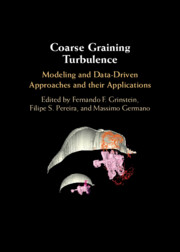Book contents
- Frontmatter
- Contents
- Contributors
- Prologue
- Part I Paradigms and Tools
- Part II Challenges
- 9 Transition to Turbulence
- 10 Wall-Bounded Turbulence
- 11 Scale-by-Scale Nonequilibrium in Turbulent Flows
- 12 Coarse-Graining in Multiphase Flows: From Micro to Meso to Macroscale for Euler–Lagrange and Euler–Euler Simulations
- 13 Coarse Graining for Thermal Flows
- 14 High-Order Simulations of Supersonic Combustion
- 15 Coarse-Graining Supersonic Combustion
- 16 Transition and Multiphysics in Inertial Confinement Fusion Capsules
- 17 Firestorms, Fallout, and Atmospheric Turbulence Induced by a Nuclear Detonation
- Epilogue
- Abbreviations
- Index
- References
17 - Firestorms, Fallout, and Atmospheric Turbulence Induced by a Nuclear Detonation
from Part II - Challenges
Published online by Cambridge University Press: 31 January 2025
- Frontmatter
- Contents
- Contributors
- Prologue
- Part I Paradigms and Tools
- Part II Challenges
- 9 Transition to Turbulence
- 10 Wall-Bounded Turbulence
- 11 Scale-by-Scale Nonequilibrium in Turbulent Flows
- 12 Coarse-Graining in Multiphase Flows: From Micro to Meso to Macroscale for Euler–Lagrange and Euler–Euler Simulations
- 13 Coarse Graining for Thermal Flows
- 14 High-Order Simulations of Supersonic Combustion
- 15 Coarse-Graining Supersonic Combustion
- 16 Transition and Multiphysics in Inertial Confinement Fusion Capsules
- 17 Firestorms, Fallout, and Atmospheric Turbulence Induced by a Nuclear Detonation
- Epilogue
- Abbreviations
- Index
- References
Summary
A nuclear detonation’s energy release can be approximately broken up into blast (50%), thermal (35%), and radiation (15%). If a detonation occurs significantly above ground (airburst) and various factors are favorable, for example, few clouds and no snow on the ground, then thermal radiation can ignite surface fires. These fires will first commence within fine fuels, such as paper and leaves on vegetation, but given time, these small-scale fires can upscale to larger fires that burn entire houses, trees, and possibly a city. Depending on weather conditions, the fires may continue to spread within a city and impact first responders or civilians sheltering in place to avoid fallout. This chapter highlights the coarse-graining of turbulence, combustion, and cloud physics associated with ignition, spread, and possible interaction of fires with nuclear fallout plumes. In particular, examples are given to illustrate the complex relationship between fallout and fires, an idealized detonation over Dallas (Texas, USA) and Hiroshima (Japan). For both examples, even though the nuclear airburst was at a fallout-free height of burst, the complex and turbulent interaction of the fires with clouds induced significant fallout on the ground.
- Type
- Chapter
- Information
- Coarse Graining TurbulenceModeling and Data-Driven Approaches and their Applications, pp. 525 - 549Publisher: Cambridge University PressPrint publication year: 2025

